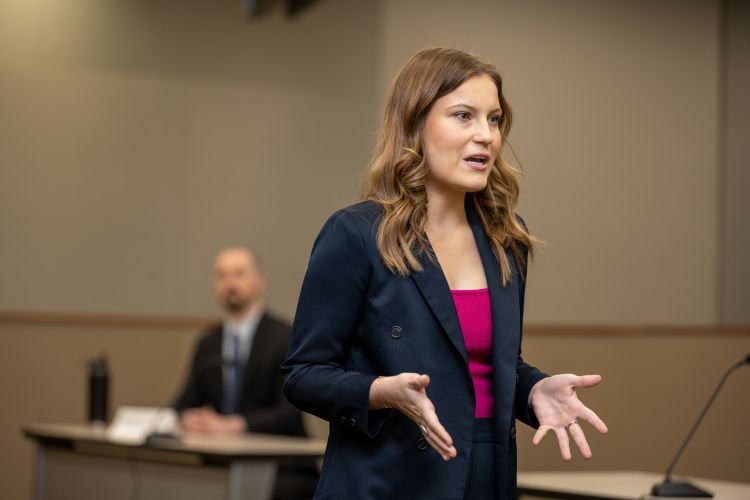Essential Abilities for Crafting Convincing Trial Presentations: A Comprehensive Guide
Essential Abilities for Crafting Convincing Trial Presentations: A Comprehensive Guide
Blog Article
How to Create Engaging Trial Presentations That Win Over Juries and Judges
Crafting engaging trial presentations that astound courts and juries is a nuanced art that requires a critical technique. By employing cutting-edge aesthetic tools, including interactive aspects, and dedicating time to extensive practice and practice session, legal professionals can dramatically improve the impact of their court room presentations.
Recognizing Your Audience
To properly engage your target market during test presentations, it is critical to comprehend their choices, expectations, and degree of knowledge in the subject. By tailoring your discussion to meet the certain needs of the audience, you can boost their understanding and retention of the information provided.
Begin by researching the demographics of the audience, such as age, education and learning level, and profession. This details can help you assess their familiarity with legal treatments and readjust your presentation style as necessary. As an example, a jury might call for simpler language and even more aesthetic aids compared to a team of lawful professionals.
Furthermore, take into consideration the mental and psychological facets of your target market. Are they understanding in the direction of particular debates or even more inclined towards facts and proof? Recognizing these subtleties can help you frame your presentation in such a way that reverberates with the audience on a deeper level.
Storytelling Methods
Recognizing your target market's choices and assumptions can significantly affect the effectiveness of your trial presentations, especially when carrying out narration methods to encourage and astound. Narration is a powerful device that can help attorneys get in touch with courts and courts on an extra emotional level, making intricate lawful arguments extra relatable and memorable.

Including vibrant information, individual stories, and rhetorical gadgets can better boost the storytelling experience, keeping the audience invested and engaged in the outcome of the instance. By crafting a convincing tale that resonates with the worths and feelings of the jury and judges, lawyers can increase the opportunities of winning their arguments and attaining beneficial judgments.
Visual Discussion Devices
Using aesthetic presentation devices can substantially boost the impact and performance of trial presentations by supplying a visually engaging way to share complex information to courts and courts. Aesthetic aids such as charts, animations, charts, and representations can help streamline elaborate details, making them much more obtainable and understandable to the audience. By integrating aesthetic components right into test presentations, lawyers can develop a compelling narrative that reverberates with jurors and leaves a long lasting perception.

Integrating Interactive Components
Including interactive aspects right into test presentations can improve audience engagement and comprehension, fostering a more interactive and immersive court room experience. By incorporating components such as interactive timelines, 3D computer animations, clickable displays, and digital fact reconstructions, attorneys can astound jurors and judges, making complex info much more obtainable and remarkable.
Interactive timelines permit a dynamic display of chronological events, helping the target market grasp the series of vital occurrences in a case. 3D computer animations can bring criminal activity scenes or crash repairs to life, supplying a thorough aesthetic depiction that assists in making clear complex information. Clickable exhibitions allow users to interact with proof, papers, or pictures, enabling a hands-on exploration of critical information.
In addition, online truth reconstructions can transport the target market right into the heart of the action, providing useful reference an engaging point of view that conventional discussions might lack. These interactive components not just engage the viewers yet likewise empower them to proactively take part in the trial process, resulting in a more impactful and influential courtroom discussion.
Practice and Practice Session
To properly take advantage of the capacity of interactive elements in test presentations, extensive practice and rehearsal are vital to make sure seamless integration and distribution in the court setting. Technique and wedding rehearsal help test speakers become knowledgeable about the content, timing, and circulation of their presentations, permitting them to confidently browse with different aspects such as videos, computer animations, or interactive graphics. By rehearsing their shipment, presenters can fine-tune their speaking skills, body language, and general presentation design to enhance persuasion and credibility before Website the court and judge.
Throughout method sessions, speakers can identify any kind of technical problems that might occur with interactive components, guaranteeing that every little thing runs smoothly throughout the real trial. Furthermore, practicing before a mock target market or coworkers can supply important comments on the performance of the interactive components and the overall discussion. This comments enables speakers to make essential modifications and improvements before tipping into the court, eventually increasing the impact and success of their test discussions.
Verdict
In conclusion, developing appealing trial discussions that astound judges and juries needs a deep understanding of the target market, reliable narration strategies, aesthetic devices, interactive elements, and extensive method (Trial Presentations). By applying these strategies, legal professionals can efficiently communicate their disagreements and evidence in a compelling way that resonates with the decision-makers in the court
Using visual presentation tools can significantly improve the effect and efficiency of trial presentations by providing a visually engaging means to share intricate details to juries and judges. By incorporating visual components right into test discussions, attorneys can create a compelling link story that reverberates with jurors and leaves an enduring perception.
One popular visual discussion device is the use of multimedia presentations, which permit for the assimilation of videos, photographs, and audio recordings to supplement spoken debates. Trial Presentations.To successfully take advantage of the potential of interactive components in test discussions, extensive practice and practice session are necessary to make sure seamless combination and shipment in the court room setting. Practice and rehearsal assistance trial presenters come to be acquainted with the web content, timing, and flow of their discussions, permitting them to confidently browse through various components such as videos, animations, or interactive graphics
Report this page